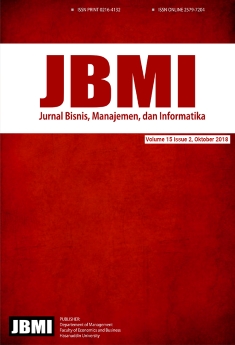EVALUASI EFISIENSI PERBANKAN DI INDONESIA BERDASARKAN KATEGORI JUMLAH MODAL INTI
DOI:
https://doi.org/10.26487/jbmi.v15i2.4131Abstract
Penelitian ini bertujuan untuk mengukur efisiensi pada industri perbankan dengan melihat modal inti yang dimiliki oleh masing-masing bank. Sebagai acuan untuk penelitian ini digunakan Peraturan OJK Nomor 6/POJK.03/2016 tentang Kegiatan Usaha dan Jaringan Kantor Berdasarkan Modal Inti Bank. Pada aturan ini, bank dibagi menjadi empat kategori BUKU. Semakin tinggi modal inti yang dimiliki suatu bank, semakin tinggi juga peringkat BUKU. Peneliti menggunakan variabel input biaya tenaga kerja, biaya bunga dan aset tetap, sedangkan variabel output terdiri atas kredit yang diberikan, pendapatan bunga dan pendapatan non bunga. Dalam mengukur efisiensi, digunakan pendekatan non parametrik yaitu Data Envelopment Analysis (DEA). Hasil penelitian adalah pertama, bank-bank yang masuk pada kategori BUKU 4 beroperasi lebih efisien dari bank pada BUKU kecil. Namun demikian perbedaan rerata tidak signfikan sehingga memunculkan hasil penelitian kedua yaitu, pembagian BUKU tidak berpengaruh pada skor efisiensi.Downloads
References
Aftab, M., Ahamad, S., Ullah, W., & Sheikh, R. a. (2011). The impact of bank efficiency on share performance: Evidence from Pakistan. African Journal of Business Management, 5(10), 3975–3980. https://doi.org/10.5897/AJBM11.156
Alhassan, A. L. (2015). Income diversification and bank efficiency in an emerging market. Managerial Finance, 41(12), 1318–1335. https://doi.org/10.1108/MF-12-2014-0304
Ali, A. R. (2017). Pengukuran Kinerja Bank Perkreditan Rakyat di Kota Malang Berdasarkan Pendekatan Efisiensi dengan Metode Data Envelopment Analysis (DEA). Jurnal Riset Akuntansi, 6(4).
Asiyah, S. (2014). Analisis Perbandingan Antara Perbankan Syariah dan Perbankan Konvensional dengan Metode Data Envelopment Analysis (DEA). Universitas Diponegoro.
Barth, J. R., Lin, C., Ma, Y., Seade, J., & Song, F. M. (2013). Do bank regulation , supervision and monitoring enhance or impede bank efficiency ? Journal of Banking and Finance, 37(8), 2879–2892. https://doi.org/10.1016/j.jbankfin.2013.04.030
Carlson, M., Shan, H., & Warusawitharana, M. (2013). Capital ratios and bank lending: A matched bank approach. Journal of Financial Intermediation, 22(4), 663–687. https://doi.org/10.1016/j.jfi.2013.06.003
Chortareas, G. E., Girardone, C., & Ventouri, A. (2012). Bank supervision, regulation, and efficiency: Evidence from the European Union. Journal of Financial Stability, 8(4), 292–302. https://doi.org/10.1016/j.jfs.2011.12.001
Cook, W. D., Tone, K., & Zhu, J. (2014). Data envelopment analysis: Prior to choosing a model. Omega (United Kingdom), 44, 1–4. https://doi.org/10.1016/j.omega.2013.09.004
Duca, J. V. (2016). How Capital Regulation and Other Factors Drive the Role of Shadow Banking in Funding Short-Term Business Credit. Journal of Banking & Finance, 69(August 2016), S10–S24. https://doi.org/10.1007/s10551-015-2769-z.For
Fiordelisi, F., Marques-Ibanez, D., & Molyneux, P. (2011). Efficiency and risk in European banking. Journal of Banking & Finance. Retrieved from http://www.sciencedirect.com/science/article/pii/S0378426610003869
Gambacorta, R. L., & Shin, H. S. (2016). Why bank capital matters for monetary policy. Journal of Financial Intermediation, 15, 1–23. https://doi.org/10.1016/j.jfi.2016.09.005
Ghozali, I. (2016). Aplikasi Analisis Multivariate. Badan Penerbit - UNDIP.
Goldberg, L. (2013). The Efficiency of Danish Banks Before and During The Crisis: A Comparison of DEA and SFA. Danmarks Nationalbank Working Papers (Vol. 87).
Institute of International Finance. (2010). Interim Report on the Cumulative Impact on the Global Economy of Proposed Changes in the Banking Regulatory Framework. Interim Report on the Cumulative Impact on the Global Economy of Proposed Changes in the Banking Regulatory Framework, (June), 1–161.
Kumar, S. (2013). Banking reforms and the evolution of cost efficiency in Indian public sector banks. Economic Change and Restructuring, 46(2), 143–182. https://doi.org/10.1007/s10644-012-9121-8
Laeven, L., Ratnovski, L., & Tong, H. (2014). Bank size and systemic risk: Some international evidence. Journal of Banking & Finance, 69.
Lee, C. C., & Hsieh, M. F. (2013). The impact of bank capital on profitability and risk in Asian banking. Journal of International Money and Finance, 32(1), 251–281. https://doi.org/10.1016/j.jimonfin.2012.04.013
Lee, T. H., & Chih, S. H. (2013). Does financial regulation affect the profit efficiency and risk of banks? Evidence from China’s commercial banks. North American Journal of Economics and Finance, 26, 705–724. https://doi.org/10.1016/j.najef.2013.05.005
Makina, D. (2014). An Empirical Study of Bank Efficiency in South Africa Using the Standard and Alternative Approaches to Data Envelopment Analysis ( DEA ). Journal of Economics and Behavioral Studies, 6(4), 310–317.
Mamatzakis, E., Tsionas, M. G., Kumbhakar, S. C., & Koutsomanoli-Filippaki, A. (2015). Does labour regulation affect technical and allocative efficiency? Evidence from the banking industry. Journal of Banking and Finance, 61, S84–S98. https://doi.org/10.1016/j.jbankfin.2015.06.012
Maulidiyah, H., & Laila, N. (2016). Membandingkan Efisiensi Bank Syariah di Indonesia dan Malaysia dengan Metode Data Envelopment Analysis. Jurnal Ekonomi Syariah Teori Dan Terapan, 3(4), 333–345.
Muhari, S., & Hosen, M. N. (2014). Tingkat Efisiensi BPRS Di Indonesia : Perbandingan Metode SFA dengan DEA dan Hubungannya dengan CAMEL. Jurnal Keuangan Dan Perbankan, 18(2), 307–328.
Mulyono, S., & Samudro, B. R. (2016). Analisis Efisiensi Bank Perkreditan Rakyat Sebelum Dan Setelah Mengikuti Linkage Program Di Wilayah Eks Karesidenan Surakarta. Jurnal Ilmu Ekonomi Dan Pembangunan, 6(1), 1–23.
Mustainah, H., Saifi, M., & NP, M. W. E. (2017). Analisis Perbandingan Tingkat Efisiensi Bank Umum Swasta Nasional dan Bank Asing di Indonesia Berdasarkan Data Envelopment Analysis. Jurnal Administrasi Bisnis, 44(1), 24–30.
Nguyen, T. P. T., Nghiem, S. H., Roca, E., & Sharma, P. (2016). Bank reforms and efficiency in Vietnamese banks: evidence based on SFA and DEA. Applied Economics, 48(30), 2822–2835. https://doi.org/10.1080/00036846.2015.1130788
Noviandry, F., & Ghofar, A. (2017). Kepemilikan Asing, Mekanisme Corporate Governance dan Efisiensi Teknis Industri Perbankan di Indonesia. Jurnal Ilmiah Mahasiswa FEB Universitas Brawijaya, 4(2).
Qian, M., & Yeung, B. Y. (2015). Bank financing and corporate governance. Journal of Corporate Finance, 32, 258–270. https://doi.org/10.1016/j.jcorpfin.2014.10.006
Sutanto, H. A. (2015). Analisis Efisiensi Teknis Bank Pembangun. Jejak, 8(1), 23–35. https://doi.org/10.15294/jejak.v8i1.3851
Tabak, B. M., Cajueiro, D. O., & Dias, M. V. B. (2014). The Efficiency of Chinese Local Banks: A comparison of DEA and SFA. Working Paper n. 346, 1–15.
Usman, M., Wang, Z., Mahmood, F., & Shahid, H. (2010). Scale Efficiency in Banking Sector of Pakistan. International Journal of Business and Management, 5(4), 104–116.
Wahab, A., Nadratuzzaman Hosen, M., & Muhari, S. (2014). Komparasi Efisiensi Teknis Bank Umum Konvensional (BUK) Dan Bank Umum Syariah (BUS) Di Indonesia Dengan Metode Data Envelopment Analysis (DEA). Al-Iqtishad: Vol. VI No. 2, Juli 2014, VI(1), 179–194.
Wang, K., Huang, W., Wu, J., & Liu, Y. N. (2014). Efficiency measures of the Chinese commercial banking system using an additive two-stage DEA. Omega (United Kingdom), 44(April 2014), 5–20. https://doi.org/10.1016/j.omega.2013.09.005
Wijesiri, M., Viganò, L., & Meoli, M. (2015). Efficiency of microfinance institutions in Sri Lanka: A two-stage double bootstrap DEA approach. Economic Modelling, 47, 74–83. https://doi.org/10.1016/j.econmod.2015.02.016











